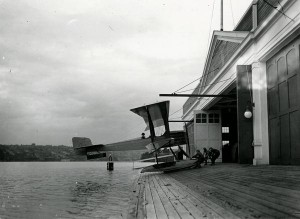
The first Boeing plane at their first assembly building, on Seattle's Lake Union. Picture from Boeing.
94 years ago today, the Pacific Aero Products Co was founded by William E Boeing in Seattle, WA and it has been an amazing ride since! Some key moments in their history:
1917: The company was renamed to the Boeing Airplane Company.
1927: Boeing started their own airline called Boeing Air Transport.
1933: Due to new regulations, Boeing was split into three companies: United Airlines, United Aircraft Corporation and the Boeing Airplane Company. This is the year that William Boeing also left Boeing.
1938: The first flight of the Boeing 314 Clipper.
1944: Due to the war over 350 aircraft were being built each month.
1957: The Boeing 707 has its first flight.
1960: Boeing purchased Vertol Aircraft Company which got them into the business of helicopters.
1963: The amazing Boeing 727 takes off for the first time.
1967: Just four years after the 727 has its first flight, the Boeing 737 takes to the sky.
1969: The first wide-bodied airliner, the Boeing 747, has its first flight and changes airline transportation forever.
1971: Funding for the Boeing 2707, the supersonic airliner, was cut.
1981: The first wide-bodied, twinjet airliner, the Boeing 767 has its first flight.
1982: The Boeing 757 has its first flight.
1994: The Boeing 777 successfully has its first flight.
1996: Boeing merges with McDonnell Douglas.
1998: The Boeing 717, which started life as the MD-95, has its first flight.
2001: Boeing moved its corporate headquarters from Seattle to Chicago.
2009: The much anticipated Boeing 787 Dreamliner has its first flight.
To read more about Boeing’s history, be sure to check out their huge history section on their website.
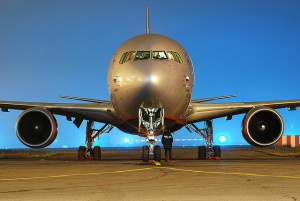
Great head-on shot of Aeroflot Boeing 767
Russian prime minister, Vladimir Putin isn’t happy that Russia’s national carrier, Aeroflot, is not purchasing domestically-built aircraft. Putin feels it is, “unacceptable,” for Russia’s flag carrier to not be supporting Russian airplane manufactures.
About a year ago, I wrote how Aeroflot was to sell all their TU-154’s and replace them with new Boeing and Airbus aircraft. At the time Aeroflot’s chief executive, Vitaly Savelyev, stated he wanted to get more efficient planes to save on costs and jobs.
Aeroflot is currently in the process of taking over management of six other Russian airlines that aircraft are very outdated. Putin is strongly urging Savelvev to look at Russian aircraft options. Currently Aeroflot’s fleet only have six Russian-built aircraft, all Ilyushin IL-96’s. The rest of their fleet consists of 11 Boeing 767’s, 10 Airbus A330’s and 64 Airbus A320’s.
Aeroflot is looking to purchase Sukhoi Superjets, Antonov An-148’s and United Aircraft MS-21’s. The problem is only the An-148 is currently flying and is a small aircraft only holding up to 100 passengers.
I can see both sides to this argument. Putin is mostly concerned about national pride and providing Russian jobs and Savelyev wants to build a profitable airline. It will be interesting to see how Aeroflot grows with additional mergers and pressure to buy domestic products.
Source: Air Transport Intelligence news Image: Aleksander Markin
http://www.flickr.com/photos/33104187@N04/3132978183/sizes/z/in/photostream/
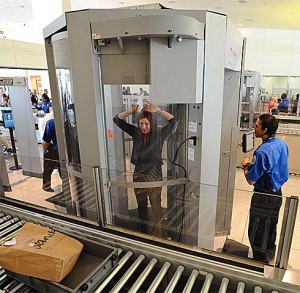
A passenger gets scanned in a body scanner.
Ah body scanners. One of my favorite topics to write about (or hate on). If you have missed out on previous posts let me re-cap why I don’t like them:
* They violate our privacy. Not just people seeing your almost-naked bodies, but those that might have a disability and really don’t want some TSA agent to see it.
* They can be avoided. All you have to do is say, “no,” and you can get a pat-down. Not even trying, I avoided the body scanner and a pat-down.
* I hate the, “what about the children,” argument, but do you want your child’s scans looked at by some stranger?
* They already have been, and I assure you will continue to be, abused.
* There is now talk that these scanners give you more radiation than once thought.
* They cost a lot and do nothing more than provide a false sense of security for passengers.
Now Senators Bob Bennett (R-UT) and Sen. Amy Klobuchar (D-MN) have introduced a bill to require all commercial airports to have and use body scanners by 2013. The bill is called the Securing Aircraft From Explosives Responsibly: Advanced Imaging Recognition Act. If that is too long for you, there is a fun acronym: S.A.F.E.R. A.I.R. Act. I wonder how much time they spent on the acronym versus seeing how this bill would really make passengers safer.
The Senators feel the Department of Homeland Security (DHS) has been spending too much time testing out the body scanners and need to get them installed ASAP nationwide. Currently the scanners are installed in only 48 airports across the US.
The bill requires that body images “cannot be stored, transferred, copied or printed,” and it forbids security personnel from having cameras near the machinery. Of course we all know that every TSA agent has followed all the rules already associated with the body scanners (that is sarcasm). I understand that most TSA employees take their job very seriously and do not abuse the system, but it only takes a few to make the whole agency look bad.
I have written a lot about these scanners and seem to have people just argue that they are better than nothing or if you don’t like them, don’t fly. I haven’t seen how the system is currently planned to be set up, how it makes us any safer. I would love to be proved wrong on this.
Thank you Chris Salman for point this out!
Source: RawStory.com Image: CRozeman
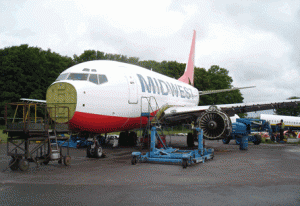
Midwest's 737-600 was the second Next Generation to be disassembled after a Ryanair 737-800 © Air Salvage International
Olivier Bonnassies with Flight International, did a wonderful write-up on newer airliners finding their way into the scrap heap.
Recently an 11 year old Boeing 737-600, a two year old Boeing 737-800 and an Airbus A318 were sent to the scrap pile. It is nothing new when an old and worn airliner makes its way to the scrap pile, but these were both newer, 737 Next Generation aircraft. It seems in this economy, some airplanes are worth more parted out than they are flying.
“We were surprised by the amount of bidders, mainly tear-down companies,” says International Bureau of Aviation’s commercial director, who handled the sale of the 737-600 commercial. The Boeing 737-600 is a pretty rare aircraft with only 68 currently in service. This means its parts are going to be worth more than a widely used aircraft like the Boeing 737-700.
The Airbus A318 is in a similar situation. There are only 72 A318’s in operation. Even though there are many common parts between the Boeing 737 Next Generation and Airbus A320 family, there aren’t many that have already been scrapped off for parts and with the A318 and 737-600 being the smallest in the family, they are some of the least economical per seat to fly.
Another problem is airlines are having harder times getting financing on used aircraft. Airlines don’t have the cash to buy new aircraft nor the financial ability to lease older ones. With many airlines choosing to keep airplanes longer, it makes a parted out aircraft worth more. It is believed that as many as 1,800 parts will be re-used out of the Boeing 737-600 including the interior cabin.
To learn more, check out Bonnassies’ full write up at Flight International.
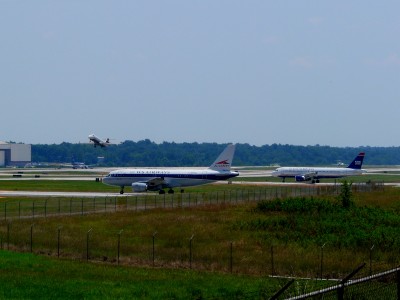
Four US Airways aircraft in three different liveries. Closes is special Allegheny livery (N745VJ)
One of my readers, Drew, sent this awesome photo to me that he took at Charlotte Douglas International Airport and I wanted to share. This photo shows an Airbus A319 in old Allegheny livery next to an Airbus A321 in new US Airways livery. If you take a look in the background you can also see an A320 in previous US Airways colors and a CRJ taking off.
Allegheny Airlines changed its name to USAir in 1979 after airline deregulation. Then in 1997 USAir’s name was changed to US Airways.
See larger version.




